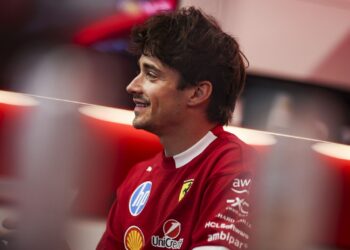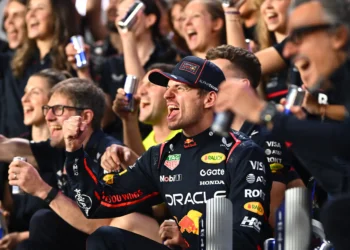Lando Norris, representing Great Britain, came incredibly close to defeating Max Verstappen and securing the victory in the Emilia Romagna Grand Prix of Formula 1. The race took place in 2024 and raises the question: what circumstances led McLaren to almost bring down Red Bull once again?
McLaren benefited from a cautious decision to introduce improvements during a Sprint weekend in Miami. These modifications inspired Norris to achieve his first victory in Formula 1. Throughout the weekend, the developments showed great promise for the Woking-based team. Norris took advantage of a Safety Car situation in the middle of the race and a struggling Red Bull to narrowly surpass Verstappen.
Despite his surprising result in the United States, Norris remained optimistic that this victory would not be a one-time event. It turns out that Red Bull proved vulnerable to the orange McLaren cars from the start at the iconic Imola circuit.
Verstappen faced challenges with the balance of his RB20 car during the first two practice sessions. In fact, he even expressed that things couldn’t get any worse. These difficulties persisted on Saturday morning, while McLaren and Ferrari maintained an advantage over Red Bull. However, a detailed analysis of the data overnight, both on track and at the Red Bull base in Milton Keynes, allowed the team to recover and continue their recent streak of dominance.
In addition to opting for a low-pressure rear wing to maximize its advantage in terms of top speed, Verstappen made a remarkable lap in Q3 to secure pole position, with the top three drivers separated by just a tenth of a second. The hope of an intense battle at the front was quickly shattered, as Norris, the only McLaren representative in the fight due to Oscar Piastri’s grid penalty, was unable to keep up with Verstappen’s pace.
Verstappen quickly established a significant lead, reminiscent of his performance in the previous season, extending it to eight seconds. Closing this gap seemed like an impossible task. Meanwhile, Norris was facing increasing pressure from Charles Leclerc.
However, a crucial moment occurred on lap 45. Norris managed to fend off Leclerc’s challenges, aided by the Ferrari driver cutting the Variante Alta chicane. Norris began to significantly reduce the gap to the leader.
After being 7.4 seconds behind Verstappen on lap 44, Norris caught everyone’s attention by taking a full second off the Red Bull driver’s lead. At this point, it seemed inevitable that Verstappen would increase his pace to respond to Norris’s impressive times.
However, radio communications between Verstappen and his race engineer, Gianpiero Lambiase, revealed that the Dutchman did not have his usual speed to unleash.
Norris was determined and felt that his second Grand Prix victory was within reach. However, Verstappen managed to extract enough potential from his Red Bull car to hold on, leaving Norris lamenting that his seven-tenths difference at the finish line meant he needed “one or two more laps”.
Between Verstappen’s vulnerability and Norris’s relentless pursuit, two factors emerged that changed the momentum in favor of McLaren. Verstappen was open about his difficulties after the race, admitting that at one point he almost ended up in the grandstands while trying to push forward in something that felt like “driving on ice.”
Elaborating on the peculiar circumstances that prevented Verstappen from replicating his dominant performance in the early stages, Horner revealed that a drop in tire temperature was the differentiating factor.
“In the first stint with the medium compound, everything seemed under control,” reflected Horner. “Max managed to build an eight-second advantage, and the car was performing exceptionally well with the medium tires.”
“However, after switching to the hard compound, the first half of the stint was good. But as the tire wore out, temperature became crucial and we started to lose tire temperature. As a result, we didn’t extract as much performance as Lando did.”
Red Bull’s issue could have been mitigated or avoided if they had tested the hard compound during practice, a decision that Horner admitted was wrong in hindsight.
“With the benefit of hindsight, using the hard compound on Friday could have been a better choice. We chose to bring two new hard tires for the race, and it would have been beneficial to gather information on their performance,” confessed Horner.
In the thrilling race in Imola, the cars’ performance was heavily influenced by Pirelli tires. These tires were particularly prone to overheating, which had a significant impact on the drivers’ ability to extract the maximum performance from their machines.
Unfortunately for Leclerc, his attempts to overtake Norris and the subsequent excursion onto the grass cost him dearly. As a result, he had to settle for a distant third place, finishing seven seconds behind the first two drivers.
While the focus at the end of the race was on Verstappen’s struggles in the cockpit, credit must also be given to Norris for his exceptional performance. He pushed to the limit in the final laps, battling with the challenging behavior of the tires. McLaren team director Andrea Stella later emphasized the importance of tire management in the race.
“Today’s race was fascinating because the tires had a very narrow operating window. Depending on the driver, track conditions, and where time was being lost, the tires showed different characteristics, affecting the competitiveness of the race,” Stella explained. “In the first stint, Max seemed to have control, and we had to keep an eye on Lando in our mirrors.”
“In the second stint, Lando took very good care of the tires from the start, because we knew that running on the hard tires until the end wouldn’t be easy. We also noticed that those who used hard tires in the first stint, like Perez, struggled. Therefore, from a tactical point of view, it was crucial to manage the tires effectively. Lando did an excellent job preserving his tires for a significant portion of the second stint, giving him an advantage in the end.”
Overall, the race at Imola showed the importance of tire management and how it can determine the final outcome of the competition. Both Leclerc’s misfortune and Norris’s skillful tire management played a crucial role in the final result.
However, Norris acknowledged that he adjusted his race strategy after switching to the hard tires to prevent Leclerc from overtaking him. He admitted that his concerns about the lack of pace were valid.
“When I switched to the hard tires, I didn’t feel comfortable. I wasn’t at ease,” Norris said. “So I quickly asked, ‘where am I struggling?’ And they replied, ‘oh, they’re just pushing more than you.’ But I asked because I felt slow and didn’t think I could push much more. Whenever I tried to push, I had slides, understeer, and tire lock-ups. The tires just weren’t behaving well.”
“It’s evident that when the tires are not in the ideal range, you can’t push. You lose confidence in the car.”
However, Norris revealed that his sudden attack on Verstappen was the result of several adjustments he made on his steering wheel to relieve pressure on the rear tires earlier in the race.
“Basically, I changed all the buttons on my steering wheel to help the rear tires and reduce the load on the front,” Norris explained. “At that moment, I had a lot of grip in the front. And maybe five or ten laps later, things started to improve.”
“So, by making these changes and adjusting the differential and brake balance, I managed to bring the tires back to the ideal range.”
“Once I reached that point, I felt confident enough to push,” he continued. “I felt like I could push, and everything started to go in the right direction. It was more of a coincidence that it happened at that moment. But when Charles was behind me, I didn’t have much more to offer.”
Could Norris have prevented Verstappen from establishing such a significant advantage in the early laps to have more time at the end to make a move?
According to Norris, McLaren had prepared the car for colder race conditions, but the warmer temperatures caused issues with rear tire wear, especially on the MCL38.
“We were expecting the weather to be colder today than it actually was, so we adjusted the car for colder conditions instead of warmer,” Norris revealed. “And I think I suffered the consequences overall. That’s why I had to be very cautious with the tires and take care of them.”
He added, “But obviously, when it’s hotter and there’s more tire wear, we start to struggle a lot more. It’s something we are aware of, and maybe we could have prepared better.”
This admission could be a weakness for McLaren when Formula 1 races take place in extremely hot climates.
However, the intense competition between two exceptional drivers, while the rest of the field continues to close in, is promising for the upcoming races under these regulations.
Events like Miami and Imola have shown that Red Bull is vulnerable, and both Ferrari and McLaren can take advantage if the reigning champions are not performing at their best.
But Horner warned that the two previous circuits on the calendar were not favorable to Red Bull’s inherent strengths.
With the unique and peculiar Monaco Grand Prix next on the schedule, it may take a few more races to determine if McLaren can consistently challenge Red Bull.
However, this offers some hope that the remaining races in 2024 will not all be dominated by Verstappen.
© 2024
In recent years, the world of sports has been dominated by big names and impressive achievements. However, a new talent is emerging and promising to revolutionize the sports scene. It is a young prodigy who has stood out in his discipline and is leaving everyone amazed.
At just 18 years old, this athlete already has an impressive collection of titles and records. His skill and talent are undeniable, and many experts believe he has the potential to become one of the greatest of all time in his discipline.
In addition to his undeniable talent, this young man is also known for his charismatic personality and exemplary character. He is a true idol for fans, who follow him closely and root for his success.
However, not everything is easy in the life of this prodigy. He faces constant challenges and adversities, but his determination and perseverance are inspiring. He does not give up easily and always seeks to push his limits.
With a promising career ahead of him, this young athlete is just beginning to show his potential. His future is bright and everyone is eager to see what else he has to achieve.
Stay tuned for the upcoming competitions and get ready to witness the talent of this young prodigy in action. He will certainly continue to surprise everyone and leave his mark on the world of sports.










